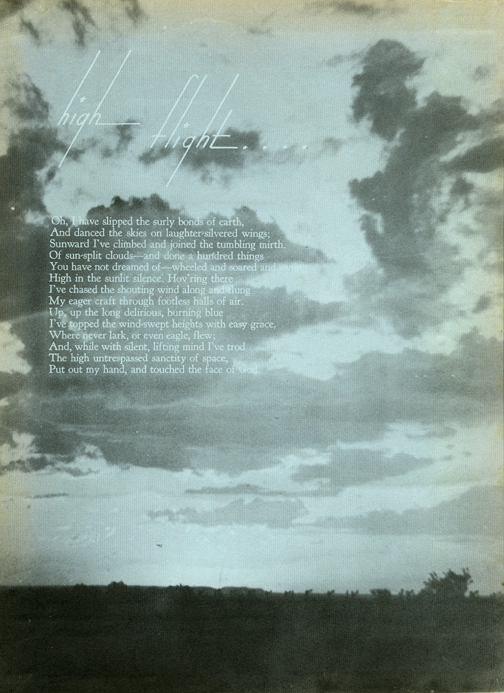|
Class of 43 - B The Mister End Page (Page 2)  High Flight . . . . Oh, I have slipped the surly bonds of earth, And danced the skies on laughter-silvered wings; Sunward I've climbed, and joined the tumbling mirth. Of sun-split clouds - and done a hundred things You have not dreamed of - wheeled and soared and swung High in the sunlit silence. Hov'ring there I've chased the shouting wind along and flung My eager craft through footless halls of air. Up, up the long, delirious, burning blue I've topped the wind-swept heights with easy grace Where never lark or even eagle flew: And, while with silent, lifting mind I've trod The high untrespassed sanctity of space, Put out my hand, and touched the face of God. Note
from Editor: The poem used on the end page of the 43-B Classbook,
was written by John Gillespie Magee (June 9, 1922 – December 11,
1941). He was the son of an American father and English mother,
both Episcopal missionaries in China where he was born. He
trained as a pilot in Ottawa with the Royal Canadian Air Force in 1941,
and was transferred to a Spitfire operational training unit in Llandow,
South Wales later that year. Magee died on 11th December 1941, at the age of 19 when the Spitfire airplane he was
flying collided with an Oxford Trainer from RAF Cranwell flown by Ernest
Aubrey in a cloud at about 400 feet
(120 meters) AGL (above ground level) at 11:30 over the village of Roxholm
which lies between RAF Cranwell and
RAF Digby, in Lincolnshire,
England. Magee was descending at the time. At the inquiry afterwards a farmer
testified that he saw the Spitfire pilot struggling to push back the canopy. The
pilot stood up to jump from the plane but was too close to the ground for his
parachute to open and died instantly. Magee is buried at Holy Cross, Scopwick Cemetery in Lincolnshire,
England. On
his grave are inscribed the first and last lines from his poem High
Flight.
Air Vice-Marshall M. H. Le Bas trained with him in 1941 and recalled: "During our acquaintanceship, he had always maintained that his first love was poetry, although he had discovered that flying was not far behind. He was thus able to imbue his flying with a sense of lyricism. I happened to run into him shortly after his first flight in a Spitfire about which he was waxing lyrical. I urged him, though not very seriously, that since he had always wanted to be a poet he should put his feelings down in words. He thereupon sat down in the mess and composed, in a very short time, the first draft of "High Flight" written, literally, "on the back of an envelope." I must have been the first person to read it, but cannot claim that I foresaw its eventual fame. It was some years later that I heard of Magee's fate." High Flight has endured as a favorite poem among aviators and, more recently, astronauts. Portions of this poem appear on many headstones in Arlington National Cemetery. Today it serves as the official poem of the RCAF and RAF. Songs and symphonic compositions have been based on Magee's text. Many U.S. television viewers were introduced to High Flight when some TV stations ended their programming day with short films based on it. Novelist Arthur Hailey quoted its first two lines as an epigraph for his bestselling novel Airport. American President Ronald Reagan quoted two brief phrases from the poem at the end of his address to the nation following the loss of the Space Shuttle Challenger on January 28, 1986. The poem also appears as part of a display panel at the Canadian War Museum, Ottawa. |